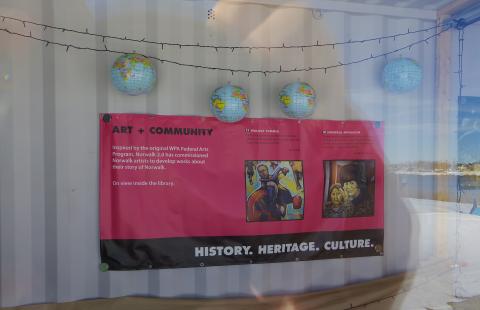What were the specific goals of this creative economy project? Describe the community development challenge or opportunity that your project was designed to address:
Activating vacant land and engaging the local community in an art project was the primary purpose of our project. Temporary public art is an opportunity for viewers to engage in an out of the ordinary experience. The artwork is there as a new introduction to part of the landscape and architecture of the site. Its presence engages people to reimagine, or visualize the site in different ways as it relates to the existing architecture and its attendant landscape or urban-scape. Works that are site- specific also provoke people who experience the space on a daily basis to experience the site in a different way. New audiences, perhaps visiting the site for the first time, are invited to become aware of the cultural heritage and art communities that contribute to the vitality of the Norwalk.
If the goals change over time, please describe how:
There were many factors out of our control. The main one becoming mid-project that the State of Connecticut began to view the lot as a staging areas for a major railway bridge construction project and the property owner became enmeshed with eminent domain issues and economic impacts that overwhelmed their staff. We ended up having to move the containers to another site which disrupted many events. We are currently at a new site and continue the project.
Who was involved in this project and what did they do? (be sure to include the partners from outside of the creative sector and how local voices were included):
We worked with the property owner, an architect who taught the Norwalk Community College Design & Landscape Architecture class, and many local artists to program the site and create a community space.
When we first started on the site, we worked with local businesses to help clear out the 4 foot weeds and overgrowth, level the site, clean up trash and prepare the site for the containers. We worked with Eagle Leasing to transform two basic 20-foot shipping containers into exhibit space, by opening one wall on each container, painting the containers bright pink and then installing them on the site.
How does this project relate to a larger community development strategy?
The active area of South Norwalk is filled with restaurants and bars. We have been active in repurposing vacant storefronts into arts spaces, and this area was two blocks from that area. By increasing the footprint of arts activity, we solidify the area as being known for creativity and innovation.
What projects or places, if any, inspired your approach to this creative economy project?
This project came out of creating a more permanent temporary arts space. :) We had leased 4 shipping containers in a previous project called the Freese Park Artist Village, and wanted to tweak the idea into one that could serve multiple locations. By owning two shipping containers we were able to modify them and address some of the issues we had during the Artist Village project.
